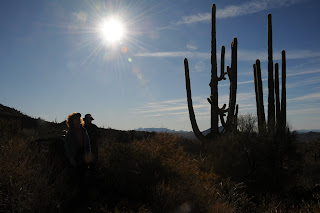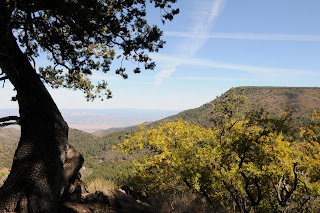


 DRAGONFLY TRAIL
Jewel of the Creek Preserve
DRAGONFLY TRAIL
Jewel of the Creek Preserve
It’s finally open! We learned of this new trail in Spur Cross Ranch Conservation Area last winter when it was still under construction. The Dragonfly Trail, which opened in April 2009, was engineered to showcase the desert foothills and thriving riparian environment surrounding the “Jewel of the Creek” area of perrenial Cave Creek. This unexpected strip of lush creek-side willows, alders, walnut trees and cattails is hemmed in by rugged Upper Sonoran Desert terrain making for a breathtaking hybrid desert-wetland hike. While there, you’ll also wander through a mesquite bosque—the 5th rarest eco-system on earth. Although most hikers prefer to grab a map at the trailhead and head out on their own, the park ranger, Kevin Smith—who knows just about
everything about the local flora, fauna, geology and human history of the area-- conducts regular guided tours for those who would like an educational experience.
Check out the link below to find out when the next one is happening.
We can thank the efforts of the
Desert Foothills Land Trust for securing the preservation of this delicate eco-system and for also raising the funds needed to plan for and build the trail. Check out their Web site to learn more about this guardian of our beautiful Sonoran Desert and how YOU can help preserve this precious resource: http://www.dflt.org/
LENGTH: 4-mile loop (with optional connecting trails to add length if we like)
RATING: moderate
ELEVATION: 2,400 -2,150 feet
FEE: $3 per person (exact change is required)
GETTING THERE:
Option 1: From I-17 go east on Carefree Highway (AZ 74) at exit 223. Continue on Carefree Highway for 9.7 miles to Cave Creek Road. Go north onto Cave Creek Road and drive 2.6 miles to Spur Cross Ranch Road. (this is a tricky intersection…the road kind of swerves left and turns into Spur Cross Ranch Road. Continue north for 4.2 miles to the dirt parking on the left. The last mile or so of the road is good dirt and passable by sedan.
THE HIKE: from the parking area, hike up the road a few yards, pay your fee and pick up a free map.
Option 2:
From Loop 101, exit at Cave Creek Road and drive north for approximately 15 miles to Spur Cross Ranch Road. (this is a tricky intersection…the road kind of swerves left and turns into Spur Cross Ranch Road. Continue north for 4.2 miles to the dirt parking on the left. The last mile or so of the road is good dirt and passable by sedan.
THE HIKE: from the parking area, hike up the road a few yards, pay your fee and pick up a free map.
INFORMATION: visit,
http://www.maricopa.gov/parks/spur%5Fcross/ or call 480-488-6623




 LIMESTONE LOOP
Spur Cross Ranch Conservation Area
Cave Creek
Although it’s located just a few clicks north of the city, this scenic loop hike traversing both Spur Cross Conservation Area and adjacent Tonto National Forest lands, encompasses some of the most spectacular desert scenery around. Think—a gurgling desert creek lined with cottonwoods and Goodding willows, outrageous forests of gigantic saguaros and sweeping views of the Valley. Although there are several options for making loop hikes using Limestone trail #252 (visit the Web site listed below for a detailed map) one really sweet option works like this: From the conservation area entry point and pay station, hike up the road and continue straight (north) on the Spur Cross Trail. Follow this wide old Jeep road (aka Forest Road 48) for 1.8 miles (hopping the creek several times) to an abandoned circular corral area where you’ll find a tiny “trail” sign pointing south. Follow the generic signs (there’s no “Limestone Trail” signage) to a narrow, rocky path that veers west heading steeply uphill. From here, this sketchy, un-maintained 2.3-mile segment vacillates between easy-to-follow and essentially—invisible. No worries, though—if you think you’ve lost the trail, just take a deep breath and scope out the intermittent rock cairns that mark the faint sections, leading hikers past two springs at the base of Sugarloaf Mountain. The worst route-finding challenges end at a fancy trail marker etched out of stone where you’ll veer left (east) heading toward Spur Cross and continue 0.4 miles to the Elephant Mountain junction. From here, stay on the main, wide trail (straight ahead) and hike another 0.3 miles to the Tortuga Trail junction. The quickest way back to the trailhead is to head left at this junction and follow the Tortuga Trail for 0.7 miles to the Spur Cross trail junction. Hang a left here and continue 0.6 miles back to the parking lot.
LENGTH: 6-mile loop
RATING: moderate-rocky, loose footing, creek crossings
ELEVATION GAIN : 1000 feet
GETTING THERE:
Spur Cross Ranch Conservation Area is located approximately 35 miles north of central Phoenix. Interstate 17, State Route 51, and Loop 101 can all be used to reach the park. From the intersection of Carefree Highway and Cave Creek Road head north on Cave Creek Road about 2.5 miles to Spur Cross Road. Turn north for approximately 4.5 miles to the public parking area on the right. As of summer 2016, the road is 100% paved.
INFORMATION: www.maricopa.gov/parks/spur_cross/Directions.aspx
FEE: There’s a $3 per person daily fee. PLEASE BRING EXACT AMOUNT. The self-serve pay station does not make change. Free maps are usually available at the kiosk.
LIMESTONE LOOP
Spur Cross Ranch Conservation Area
Cave Creek
Although it’s located just a few clicks north of the city, this scenic loop hike traversing both Spur Cross Conservation Area and adjacent Tonto National Forest lands, encompasses some of the most spectacular desert scenery around. Think—a gurgling desert creek lined with cottonwoods and Goodding willows, outrageous forests of gigantic saguaros and sweeping views of the Valley. Although there are several options for making loop hikes using Limestone trail #252 (visit the Web site listed below for a detailed map) one really sweet option works like this: From the conservation area entry point and pay station, hike up the road and continue straight (north) on the Spur Cross Trail. Follow this wide old Jeep road (aka Forest Road 48) for 1.8 miles (hopping the creek several times) to an abandoned circular corral area where you’ll find a tiny “trail” sign pointing south. Follow the generic signs (there’s no “Limestone Trail” signage) to a narrow, rocky path that veers west heading steeply uphill. From here, this sketchy, un-maintained 2.3-mile segment vacillates between easy-to-follow and essentially—invisible. No worries, though—if you think you’ve lost the trail, just take a deep breath and scope out the intermittent rock cairns that mark the faint sections, leading hikers past two springs at the base of Sugarloaf Mountain. The worst route-finding challenges end at a fancy trail marker etched out of stone where you’ll veer left (east) heading toward Spur Cross and continue 0.4 miles to the Elephant Mountain junction. From here, stay on the main, wide trail (straight ahead) and hike another 0.3 miles to the Tortuga Trail junction. The quickest way back to the trailhead is to head left at this junction and follow the Tortuga Trail for 0.7 miles to the Spur Cross trail junction. Hang a left here and continue 0.6 miles back to the parking lot.
LENGTH: 6-mile loop
RATING: moderate-rocky, loose footing, creek crossings
ELEVATION GAIN : 1000 feet
GETTING THERE:
Spur Cross Ranch Conservation Area is located approximately 35 miles north of central Phoenix. Interstate 17, State Route 51, and Loop 101 can all be used to reach the park. From the intersection of Carefree Highway and Cave Creek Road head north on Cave Creek Road about 2.5 miles to Spur Cross Road. Turn north for approximately 4.5 miles to the public parking area on the right. As of summer 2016, the road is 100% paved.
INFORMATION: www.maricopa.gov/parks/spur_cross/Directions.aspx
FEE: There’s a $3 per person daily fee. PLEASE BRING EXACT AMOUNT. The self-serve pay station does not make change. Free maps are usually available at the kiosk.



















































